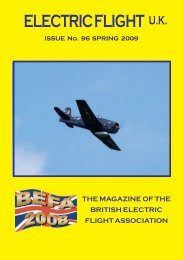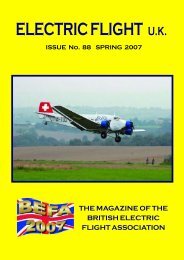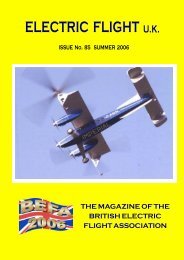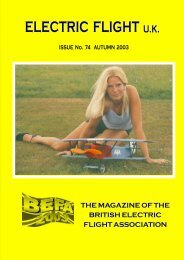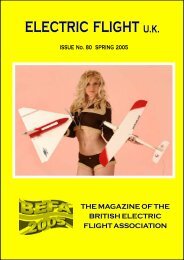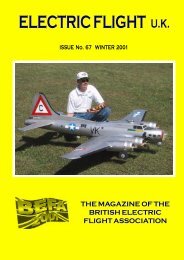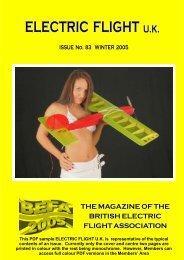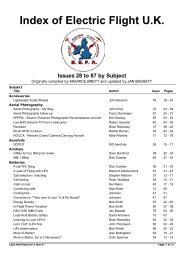ELECTRIC FLIGHT U.K. - British Electric Flight Association
ELECTRIC FLIGHT U.K. - British Electric Flight Association
ELECTRIC FLIGHT U.K. - British Electric Flight Association
You also want an ePaper? Increase the reach of your titles
YUMPU automatically turns print PDFs into web optimized ePapers that Google loves.
To give the model its<br />
best chance, it was<br />
loaded up with the<br />
LiPo pack, and<br />
The “firewall” with motor, speed controller and nose wheel fitted<br />
passed all functional<br />
and radio range<br />
checks with flying<br />
colours. Having run<br />
out of excuses, it was<br />
time to see how it<br />
would fly!<br />
The throttle was<br />
opened smoothly and<br />
the model tracked<br />
rapidly down the<br />
runway, the nose<br />
wheel steering being<br />
used to keep it<br />
straight in the slight<br />
crosswind.<br />
Lift-off came well<br />
before the end of the runway, and she climbed rapidly at about 30° until I levelled<br />
her off and throttled back to a cruise climb at about 50ft. Climbing round the<br />
circuit, I found the controls to be smooth and positive, and the model tracked<br />
steadily through the rather gusty air. I found I could position the model wherever<br />
I wanted it, and made a few basic circuits to satisfy myself about the handling.<br />
The only adjustments I had to make were a couple of clicks of down elevator trim.<br />
The third time round, I applied full power whilst turning into wind and tried a<br />
loop. The sleek model carried good speed over the top, and I was able to throttle<br />
back to about ¼ power coming down the other side. I already knew that the<br />
ailerons were positive, and the loop was followed immediately by a roll. The rate of<br />
roll was less than I am used to with the Sukhoi and Vermont Belle, but entirely in<br />
character with the Harvard.<br />
OK, so this heavy model was fast and manoeuvrable, but how would it fare at low<br />
speed? Now well into the flight, it was time to try the low-speed handling. Climbing<br />
to about 150 feet, I throttled back and held the nose up as the speed dropped off,<br />
reaching nearly full up elevator before the nose dropped, slightly to the left. Power<br />
was restored and a power-on stall tried. This was similarly undramatic, so I made<br />
a few trial approaches for the first landing.<br />
Conscious of the model's cleanliness and speed, the final approach was made level<br />
at about 4 feet up as the speed bled off. The model tracked dead straight through<br />
the gusty air, and I was easily able to line it up with our narrow runway. It<br />
34 E.F.-U.K.



